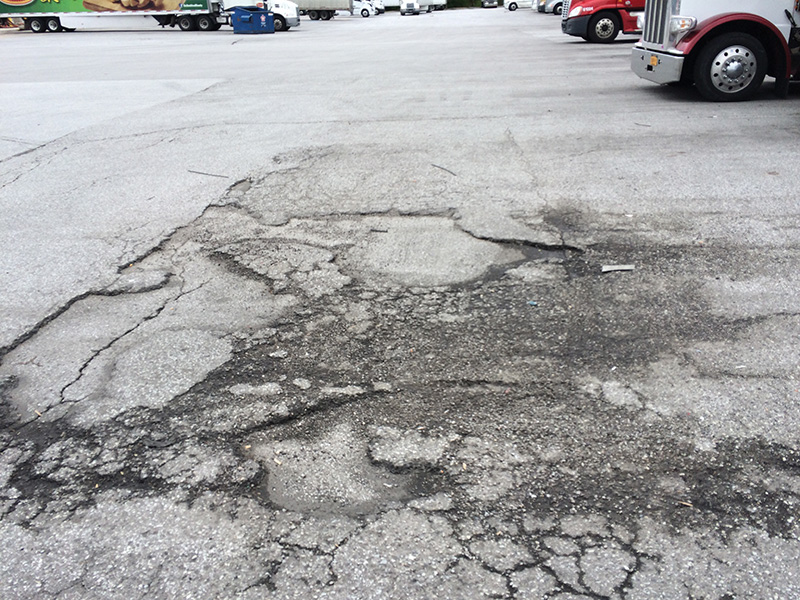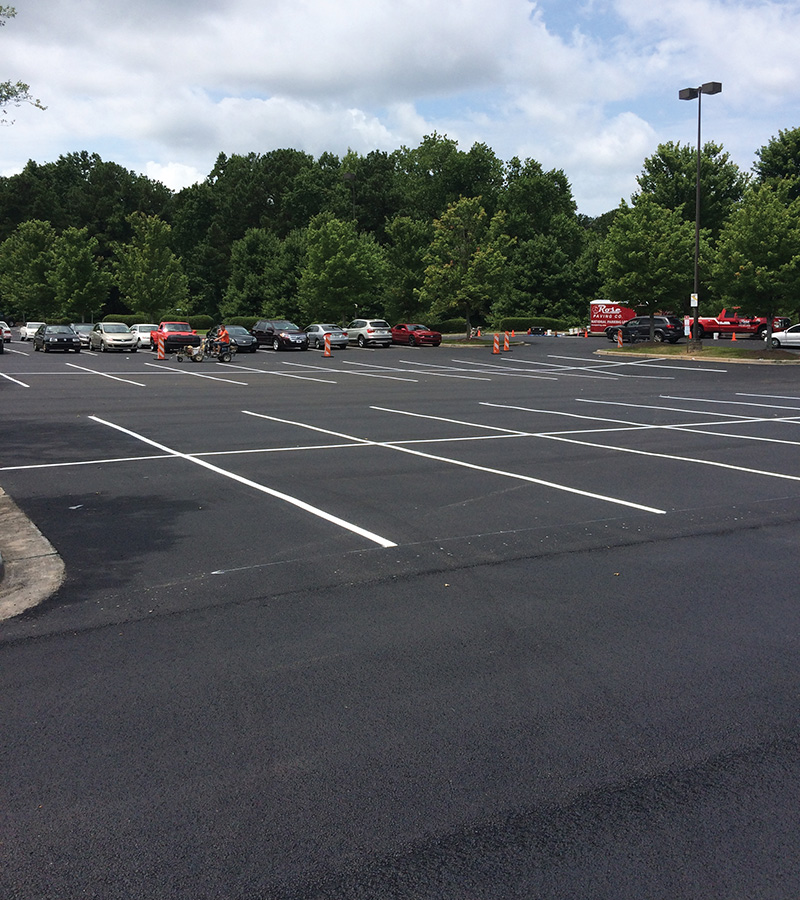A checklist for parking lot maintenance.
By Amy McGuinn-Godbey
The first impression you make on a customer can make or break your business. Your parking lot plays a key role in that first impression. Preventative parking lot maintenance not only helps maintain the good impression your customers have, but more importantly, it helps to prevent further deterioration of an asphalt or concrete parking lot and costly repairs.
Over time, wear and tear will take its toll on any parking lot. Seasonal weather conditions such as extreme temperatures, snow, rain, ice and blazing sun can contribute to pavement cracking, heaving, pothole formation and faded striping. Weather isn’t the only force working against you — petroleum, chemicals and traffic loading all take a toll. Without proper maintenance, a parking lot will deteriorate significantly in as little as 5 to 7 years.
 Parking lot maintenance involves two facets: (1) a routine inspection for cracks and deterioration, and (2) a plan of attack for repairs. A reputable paving contractor can help determine the plan and provide the most efficient and cost-effective repairs and maintenance for your properties.
Parking lot maintenance involves two facets: (1) a routine inspection for cracks and deterioration, and (2) a plan of attack for repairs. A reputable paving contractor can help determine the plan and provide the most efficient and cost-effective repairs and maintenance for your properties.
It is important to inspect your parking lots on a routine basis. Every season or so, take a walk around your parking lot. Look at the cracks — are they getting bigger or spreading? Take a look at the markings — have they faded much since the last walk? Finally, check out the extras — are the curbs crumbling, are the drains full of waste or sinking, how are the sidewalks holding up?
This simple checklist will help you understand the condition of your parking lot and help you plan for the future:
• Walk your parking lot and note cracks that have either widened or formed over time. Cracks that measure 1/4-inch to 1-inch wide are good candidates for cracksealing.
• Consider if your parking lot or parking garage structure needs to be swept of dirt and debris. Debris holds moisture which accelerates deterioration.
• Take note of storm drains throughout your parking lot. Pay special attention to sinking or deterioration, which may indicate a problem beneath the surface — such as broken concrete rings or inlet pipes.
• Pinpoint if sealcoat and lot marking has started to fade.
• If applicable, assess any damage from snow plows, such as broken curbs, excessive salting and damage to storm basin lids and surrounding asphalt or concrete.
• Identify areas of standing water on your parking surface, as these are depressions and areas where asphalt and/or concrete may have heaved.
• Determine whether your lot is in need of basic preventative maintenance repairs or structural repairs.
• Basic preventative maintenance repairs include asphalt or concrete patching, catch basin adjustment, sealcoating, cracksealing, lot marking and infrared asphalt repair.
• Structural repairs include asphalt or concrete reconstruction, resurfacing or removal and replacement.
 Once you have an understanding of your parking lot, speak with a reputable paving contractor to develop a plan that outlines the current and future condition of the pavement and what type of maintenance is required to keep it in an acceptable condition over a specified time period, along with all associated costs. Individual maintenance options such as sealcoating, crack sealing, lot marking, asphalt repairs and concrete repairs should all be included. Be sure your contractor carries the proper insurance, provides good explanations in the scope of work, and clearly communicates the project timeline. Paving often times disrupts normal business operations, so it is imperative to communicate to any tenants or customers.
Once you have an understanding of your parking lot, speak with a reputable paving contractor to develop a plan that outlines the current and future condition of the pavement and what type of maintenance is required to keep it in an acceptable condition over a specified time period, along with all associated costs. Individual maintenance options such as sealcoating, crack sealing, lot marking, asphalt repairs and concrete repairs should all be included. Be sure your contractor carries the proper insurance, provides good explanations in the scope of work, and clearly communicates the project timeline. Paving often times disrupts normal business operations, so it is imperative to communicate to any tenants or customers.
Keep in mind, if pavement is new, a budget should reflect the cost for sealcoating, striping and cracksealing once every 2 to 3 years as well as minor amounts of repair of failed asphalt. About every 10 years, funds should be budgeted for resurfacing (overlay). Depending on the traffic, weather and other factors, a removal and replacement should be budgeted every 20 years. If the parking lot is existing, the same services will be needed but the timing will be different based on the current condition.
Parking lots are a significant investment. Preventative maintenance is a solution used to prevent further deterioration to your parking surface. It is also the most cost-effective solution to maximize pavement life while minimizing risk — such as liabilities and safety issues that can affect customers, vendors and employees. By following the checklist and taking action today, you too can have a problem-free parking lot — not only this year, but for years to come!
— Amy McGuinn-Godbey is director of marketing at Rose Paving LLC, a national parking lot management company with over 40 years in the industry. Headquartered in Bridgeview, Illinois, the company has multiple offices providing top-quality pavement solutions to commercial, retail and industrial properties nationwide.
